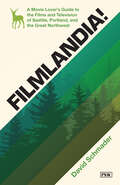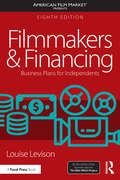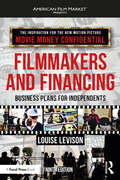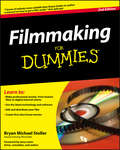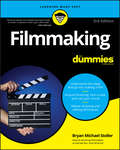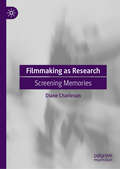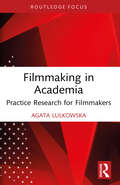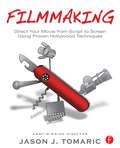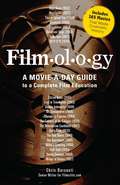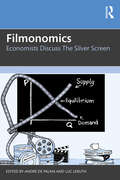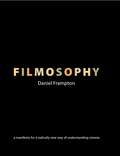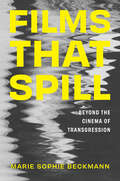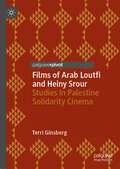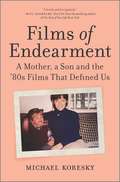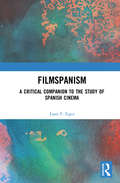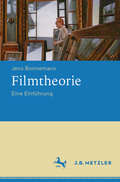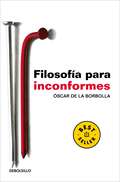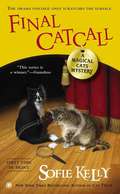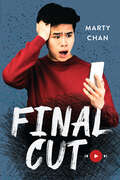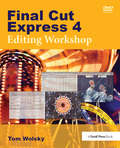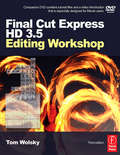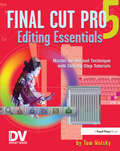- Table View
- List View
Filmlandia!: A Movie Lover's Guide to the Films and Television of Seattle, Portland, and the Great Northwest
by David SchmaderFrom Twin Peaks to Twilight, from Practical Magic to Portlandia!, Filmlandia! highlights more than 200 film and television entertainments created and centered in Seattle, Portland, and the greater Pacific Northwest, extensively researched and curated by culture writer David Schmader.The PNW has a thriving, rich film culture, and it's finally celebrated in a guide as visually arresting and compelling as the films and television themselves!More than 200 entries are included and feature:• Hilarious, insightful synopses• Behind-the-scene facts and trivia• Regional scenic highlightsIn addition, sidebars pepper the pages, covering:• Regional filmmakers like Gus Van Sant and Lynn Shelton• Television shows that shaped the public's perception of the region (such as Twin Peaks, Shrill, and Portlandia!)• Documentaries, queer cinema, silent films, Vancouver-shot imposters, and more. Colorful artwork, inspired by the primary VHS color palette of the 80s, turns this handy guide into a visual treat as well. This is a book for any cinephile, but for those who love and live in the PNW, Filmlandia! is an absolute must-have.
Filmmakers and Financing: Business Plans for Independents (American Film Market Presents)
by Louise LevisonIn this new and updated ultimate filmmaker’s guide, Louise Levison gives you easy-to-use steps for writing an investor-winning business plan for a feature film, including: A comprehensive explanations for each of the eight sections of a plan Full financial section with text and tables A sample business plan A companion website with additional information for various chapters and detailed financial instructions ― advanced math not needed An explanation on how feature documentary, animated and large-format films differ A guide to pitching to investors: who they are, what they want and what to tell them Words of advice: Filmmakers share their experiences raising money from equity investors
Filmmakers and Financing: Business Plans for Independents (American Film Market Presents)
by Louise LevisonThis updated ninth edition of Louise Levison’s ultimate filmmaker’s guide provides easy-to-follow steps for writing an investor-winning business plan for independent films. This new edition includes information on current distribution models and the evolving digital streaming service landscape. Updated examples and references solidify this edition as the go-to source for creating a successful film business plan. Complete with comprehensive explanations on how to write each of the eight sections of a business plan; a complete sample plan for reference; and a companion website with additional information and financial tables, this book gives readers the tools needed to secure financing for a film. Essential reading for students and professionals alike, this book is ideal for anyone looking to further their understanding of film financing and how to create a successful business plan.
Filmmaking For Dummies
by Bryan Michael StollerNow updated--the step-by-step secrets to capturing great moments on filmWith all the recent advancements in filmmaking technology, more people than ever are trying their hand at filmmaking. Keeping up with the newest information in this booming field, this updated edition of Filmmaking For Dummies features up-to-the-minute coverage of the latest and greatest hardware, software, accessories, and trends--including high-definition technology and new outlets for films such as YouTube and MySpace. It demystifies the nuts-and-bolts of filmmaking, from developing a project and securing financing to hiring a cast and crew, editing, and getting distribution. This new edition also provides new movie examples and updated contacts and resources. Whether people want to become professional filmmakers or simply shoot quality home movies, this practical guide has all the advice and tips needed to succeed.
Filmmaking For Dummies (For Dummies Ser.)
by Bryan Michael StollerEverything you ever wanted to know about making a movie but were afraid to ask… Lights, camera, action! We all have at least one movie in us, and the amazing and affordable advances in digital technology makes it increasingly easy to make your dream a reality and share it with the world. Filmmaking for Dummies is your definitive guide to bringing a project to life, from the comedy antics of loveable pets to the deepest, most meaningful independent film. Bryan Michael Stoller is your friend and guide, sharing his knowledge gained over 100 productions (directing and working with Dan Aykroyd, James Earl-Jones, Barbra Streisand and Drew Barrymore, among others) to show you how to take your movie from the planning and storyboarding stage, through shooting and editing, to making it available to your adoring audiences through television broadcast, streaming online or in movie theaters. For the do-it-your-selfer, the book includes tips on how to finance your project, a look at the latest software and apps, including advancements in digital technology, and for the passionate director, advice on how to hire and work with your cast and crew and find great scenic locations. Whether you want to become a professional filmmaker or just create great YouTube videos or nostalgic home movies, shooting with your smartphone or with consumer or pro-gear, this practical guide has it all. Learn how to compose your shots and when to move the camera Make the perfect pitch to sell your story Take advantage of helpful contacts and tons of new resources Get up-to-date on the latest and greatest digital technology Find the right distributor, or learn how you can be your own distributor! So, you really have no excuses to make your masterpiece. Get rolling with a copy of Filmmaking for Dummies today and start shooting for the stars!
Filmmaking as Research: Screening Memories
by Diane CharlesonThis book examines the challenges often experienced by film practitioners who find themselves researching within the academy, either as students or academics. In light of this the author presents her own journey from practitioner to researcher as a lens. Her practice- based research has been a quest to ”revision” memories, by creating filmic images that elicit memory and remembering. In so doing she has used a range of platforms: multi- screen video installation, still- framing the moving image and remixing found footage. Central to this research has been the importance of family storytelling and sharing, the relationship of the visual and memory, the agency of nostalgia and the role of aura, particularly evident in the re-appropriating of super 8 home movies into a variety of forms. Important to this is has been the relationship of the viewer and the viewed in particular the role of an immersive environment of viewing.
Filmmaking in Academia: Practice Research for Filmmakers (Routledge Studies in Media Theory and Practice)
by Agata LulkowskaEvaluating the existing position of film as research, Filmmaking in Academia offers clear guidance and practical advice from the planning and conception of research films to the making, evaluation, dissemination and impact of practice-based research.This book aspires to serve as a guide for new and current researchers in screen-based media and creative practice. It seeks to explore the scope, definitions, methodologies, and interdisciplinary (and post-disciplinary) nature of film research projects. Author Agata Lulkowska focuses on how to manage potential challenges when artistic creativity meets research requirements, emphasising how finding the middle ground that serves both purposes often requires redesigning brand-new methodological approaches. Looking specifically at the publication routes for research films, the book highlights current dissemination practices and raises the question of impact throughout to re-contextualise current publication methodologies for practice-based projects.This exciting new work provides key reading for graduate students, academics, and filmmakers looking to move into academia.
Filmmaking: Direct Your Movie from Script to Screen Using Proven Hollywood Techniques
by Jason TomaricFilmmaking the definitive resource for filmmakers, blows the doors off the secretive film industry and shows you how to adapt the Hollywood system for your production. Full of thousands of tips, tricks, and techniques from Emmy-winning director Jason Tomaric, Filmmaking systematically takes you through every step of how to produce a successful movie - from developing a marketable idea through selling your completed movie. Whether you're on a budget of $500 or $50 million, Filmmaking reveals some of Hollywood's best-kept secrets. Make your movie and do it right. The companion site includes: Over 30 minutes of high-quality video tutorials featuring over a dozen working Hollywood professionals. Industry-standard forms and contracts you can use for your production Sample scripts, storyboards, schedules, call sheets, contracts, letters from the producer, camera logs, and press kits 45-minute video that takes you inside the movie that launched Jason's career. 3,000 extras, 48 locations, 650 visual effects-all made from his parent's basement for $25,000.
Filmology
by Chris BarsantiSure, everybody loves the movies. But how much do these movie enthusiasts really know about them? In this groundbreaking book, noted film critic Chris Barsanti gives you the most entertaining crash course in good film in a book--one movie a day. This is not just another greatest-movies celebration. Pairing cinema's lesser-seen gems alongside blockbusters, great early works from the pioneers of film alongside often-overlooked films from great directors, Barsanti unveils the movies that all true cineastes must see--for everyone's viewing pleasure. Filmology: So you can watch your way to an education in film!
Filmology: A Movie-a-Day Guide to the Movies You Need to Know
by Chris BarsantiSure, everybody loves the movies. But how much do these movie enthusiasts really know about them? In this groundbreaking book, noted film critic Chris Barsanti gives you the most entertaining crash course in good film in a book--one movie a day. This is not just another greatest-movies celebration. Pairing cinema's lesser-seen gems alongside blockbusters, great early works from the pioneers of film alongside often-overlooked films from great directors, Barsanti unveils the movies that all true cineastes must see--for everyone's viewing pleasure.Filmology: So you can watch your way to an education in film!
Filmonomics: Economists Discuss the Silver Screen
by André de Palma and Luc LeruthWhat could movies as diverse as The Last Samurai, Cléo from 5 to 7, or Dr. Strangelove have in common? Filmonomics has a simple yet intriguing answer: economics as the main driving force of the plot or as the main motivation of the characters’ actions.This book analyses how movie makers use economic and financial motives in their plots or to build their characters. Have they done it in line with economic theory? Or are they proposing a new angle, a new perspective, that economists should take note of? The authors here do not discuss wages in the film industry or the economics of movies. What interests them is the economic motivations underpinning the behaviour of fictional characters in their favourite films. They argue that credible movie characters can behave in irrational ways, and movie makers occasionally introduce new ideas that economists should take note of.A unique contribution, this book will be of interest to readers eager to discover what economists have to say about films and film directors. It will be indispensable for students and researchers of economics, media studies, film studies, and cultural studies.
Filmosophy
by Daniel FramptonFilmosophy is a provocative new manifesto for a radically philosophical way of understanding cinema. It coalesces twentieth-century ideas of film as thought (from Hugo Munsterberg to Gilles Deleuze) into a practical theory of "film-thinking," arguing that film style conveys poetic ideas through a constant dramatic "intent" about the characters, spaces, and events of film. Discussing contemporary filmmakers such as Bela Tarr and the Dardenne brothers, this timely contribution to the study of film and philosophy will provoke debate among audiences and filmmakers alike. FILMOSOPHY is a registered U.S. trademark owned by Valentin Stoilov (www.filmosophy.com) for educational services in the field of motion picture history theory and production. Mr. Stoilov is not the source or origin of this book and has not sponsored or endorsed it or its author.
Filmosophy (Film Studies)
by Daniel FramptonFilmosophy is a provocative new manifesto for a radically philosophical way of understanding cinema. It coalesces twentieth-century ideas of film as thought (from Hugo Münsterberg to Gilles Deleuze) into a practical theory of "film-thinking," arguing that film style conveys poetic ideas through a constant dramatic "intent" about the characters, spaces, and events of film. Discussing contemporary filmmakers such as Béla Tarr and the Dardenne brothers, this timely contribution to the study of film and philosophy will provoke debate among audiences and filmmakers alike.FILMOSOPHY ® is a registered U.S. trademark owned by Valentin Stoilov (www.filmosophy.com) for educational services in the field of motion picture history theory and production. Mr. Stoilov is not the source or origin of this book and has not sponsored or endorsed it or its author.
Films That Spill: Beyond the Cinema of Transgression
by Marie Sophie BeckmannFilms That Spill is a comprehensive study of the Cinema of Transgression, a hitherto underexamined moment in US underground film culture. Reconsidering the concept of transgressive cinema not only as a description of the intentionally provocative content of the films but also as a feature of a cross-disciplinary practice, Marie Sophie Beckmann explores how filmmaking in the context of the vibrant and intermingling art, music, performance, and film scenes in 1980s Lower Manhattan spilled over the boundaries of artistic disciplines, media formats, and content concepts. This study not only provides a microhistory of these scenes and insight into their afterlife in archives and exhibitions but also represents an innovative contribution to debates within film, media, and visual culture about the methodological and historiographical challenges posed by the expansion of film beyond the discursive boundaries of cinema.
Films for the Colonies: Cinema and the Preservation of the British Empire
by Tom RiceFilms for the Colonies examines the British Government’s use of film across its vast Empire from the 1920s until widespread independence in the 1960s. Central to this work was the Colonial Film Unit, which produced, distributed, and, through its network of mobile cinemas, exhibited instructional and educational films throughout the British colonies. Using extensive archival research and rarely seen films, Films for the Colonies provides a new historical perspective on the last decades of the British Empire. It also offers a fresh exploration of British and global cinema, charting the emergence and endurance of new forms of cinema culture from Ghana to Jamaica, Malta to Malaysia. In highlighting the integral role of film in managing and maintaining a rapidly changing Empire, Tom Rice offers a compelling and far-reaching account of the media, propaganda, and the legacies of colonialism.
Films of Arab Loutfi and Heiny Srour: Studies in Palestine Solidarity Cinema (Palgrave Studies in Arab Cinema)
by Terri GinsbergThis book places long overdue focus on the Palestine solidarity films of two important Arab women directors whose cinematic works have never received due attention within the scholarly literature or the cultural public sphere. Through an analysis that situates these largely overlooked films within the matrix of an anti-Zionist critique of cinematic ontology, this book offers a materialist feminist appreciation of their political aesthetics while critiquing the ideological enabling conditions of their academic absenting. The study of these daring films fosters a much-needed, sustained understanding of the meaning and significance of Palestine solidarity filmmaking for and within the Arab world.
Films of Endearment: A Mother, a Son and the '80s Films That Defined Us
by Michael Koresky&“A lovely and loving book.&”—Will Schwalbe, New York Times bestselling author of The End of Your Life Book Club"I'm not sure I have ever read a book about movies that is as tender and open-hearted as Films of Endearment."—Mark Harris, New York Times bestselling author of Mike Nichols: A Life A poignant memoir of family, grief and resilience about a young man, his dynamic mother and the '80s movies they shared together Michael Koresky's most formative memories were simple ones. A movie rental. A mug of tea. And a few shared hours with his mother. Years later and now a successful film critic, Koresky set out on a journey with his mother to discover more about their shared cinematic past. They rewatched ten films that she first introduced to him as a child, one from every year of the '80s, each featuring women leads.Together, films as divergent as 9 to 5, Terms of Endearment, The Color Purple and Aliens form the story of an era that Koresky argues should rightly be called "The Decade of the Actress."Films of Endearment is a reappraisal of the most important and popular female-driven films of that time, a profound meditation on loss and resilience, and a celebration of the special bond between mothers and their sons.
Filmspanism: A Critical Companion to the Study of Spanish Cinema
by Juan F. EgeaFilmspanism explores the geopolitics of knowledge involved in academic approaches to Spanish cinema. This companion rethinks the role of disciplinarity, institutionality, and nationality in the study of film by taking into account a rather specific set of contentious issues, intellectual traditions, discursive servitudes, and invested scholarship. To that end, the book explores the topics of art cinema, popular culture, film genre, and transnationalism, always with Spanish cinema as its concrete object of study. An insightful contribution to the study of Spanish cinema, this discussion will be of interest to researchers and graduate students in Hispanic Studies and Film Studies.
Filmtheorie: Eine Einführung
by Jens BonnemannDiese Einführung bietet einen Überblick über die wichtigsten Positionen der Filmtheorie von ihren Anfängen bis in die Gegenwart und schlägt einen Bogen von Hugo Münsterberg bis zu Vivian Sobchack. Die einzelnen Filmtheorien werden in chronologischer Reihenfolge vorgestellt, wobei ihre Hauptthesen, ihr Argumentationsaufbau wie auch ihre wechselseitigen Einflüsse und Abgrenzungen rekonstruiert werden. Inwiefern diese Ansätze dazu dienen können, das Verständnis von Filmen zu vertiefen, wird an konkreten Filmbeispielen gezeigt. Ein weiterer roter Faden innerhalb des Buchs ist der Vergleich mit Theorieangeboten aus der Bildtheorie und der philosophischen Ästhetik. Damit werden die jeweiligen Theoretiker in einen umfassenderen geistesgeschichtlichen Traditionsrahmen eingeordnet.
Filosofía para inconformes
by Óscar De la BorbollaEn otros tiempos este libro habría sido quemado, Filosofía para inconformes es un libro rebelde, escrito con humor y corrosiva amenidad donde las ideas fluyen en forma de ensayo, fábula, monólogo, aforismo, diatriba, manifiesto hasta formar un mosaico multigenérico donde el lector podrá reírse de todo y, principalmente, de sí mismo. No se trata de un pensamiento amargo que desemboque en la tristeza y la abulia, sino de un desencanto festivo que hace del pensamiento un carnaval. En esta obra, Óscar de la Borbolla --pensador agudo y amargo-- reflexiona con implacable humor negro a propósito del sentido de la vida y la muerte; de la locura y la demagogia; de la corrupción política, del amor y, en general, de los asuntos que han preocupado siempre a los filósofos, y que hoy resulta indispensable abordar sin complacencias. Filosofía para inconformes propone un entramado de conceptos que dan expresión a la inconformidad actual.
Final Catcall: A Magical Cats Mystery
by Sofie KellySmall-town librarian Kathleen Paulson gets plenty of entertainment from her extraordinary cats, Owen and Hercules. But when a theatre troupe stumbles into more tragedy than it bargained for, it's up to Kathleen to play detective. . . . With her sort-of boyfriend Marcus calling it quits and her ex-boyfriend Andrew showing up out of the blue, Kathleen has more than enough drama to deal with; and that's before a local theatre festival relocates to Mayville Heights. Now the town is buzzing with theatre folk, and many of them have their own private dramas with the director, Hugh Davis. When Davis is found shot to death by the marina, he leaves behind evidence of blackmail and fraud, as well as an ensemble of suspects. Now Kathleen, with a little help from her feline friends Owen and Hercules, will have to catch the real killer before another victim takes a final curtain call.
Final Cut (Orca Anchor)
by Marty ChanMason has been picked on at school for as long as he can remember and he’s tired of it. He is happy that his family is moving and that he will never have to go to this school ever again. On his last day, Mason, a budding filmmaker, decides to get the ultimate revenge on the two worst bullies. He films them and then edits the footage to humiliate them. But then the plan takes on a life of its own. The video goes viral and the two bullies become the butt of everyone's jokes. Furious, they are determined to get even and Mason must run like his life depends on it. And it just might.
Final Cut Express 4 Editing Workshop
by Tom WolskyGo beyond the mechanics of Final Cut Express 4--learn how to edit with it! More than a button-pushing manual--this workshop give you firsthand experience with the art and technique of editing. You develop a working knowledge with nineteen tutorials that cover each and every essential, including: * setting up your system and understanding the interface * ingesting and organizing your material including drive-based and disc-based camera data* slicing, dicing, and organizing clips * editing to build and trim a sequence of shots * adding transitions * using sound to refine your edit * titling with FCE and Photoshop * animating images to create engaging scenes * adding special effects filters * compositing to enhance your projects * outputting your material The companion DVD contains project media, demo software, and free plug-ins for your use.
Final Cut Express HD 3.5 Editing Workshop
by Tom WolskyGo beyond the mechanics of Final Cut Express HD 3.5--learn how to edit with it! More than a button-pushing manual--this workshop give you firsthand experience with the art and technique of editing. You develop a working knowledge of this powerful editing application with eleven tutorials that cover each and every essential, including:* setting up your system and understanding the interface* getting your material into FCE and organizing it* slicing, dicing, and organizing clips* editing to build and trim a sequence of shots* adding transitions* using sound to refine your edit* titling with FCE and Photoshop* animating images to create engaging scenes* adding special effects filters* compositing to enhance your projects* outputting your materialThe companion DVD contains a video introduction to FCE that is especially designed for iMovie users. It compares and contrasts the two applications to ease the transition. The DVD-ROM portion contains project media, demo software, and free plug-ins for your use.
Final Cut Pro 5 Editing Essentials
by Tom WolskyDigital editing gives editors far greater freedom than ever before to move scenes of information around and place them anywhere in a film's sequence. Apple's Final Cut Pro is the most widely used Mac-based digital editor, and is especially popular with independent filmmakers and graphic artists. Final Cut Pro 5 Editing Essentials enables readers to master the craft of digital editing on Apple's Final Cut Pro. This full-color editing workshop features eight tutorials that provide firsthand experience with the art and technique of editing. Covering the essentials - capturing material, organizing it, editing, adding transitions, basic titling and sound techniques, and outputting from the application - the tutorials are explained in jargon-free language by a seasoned teacher and digital editor. This book includes a companion DVD filled with graphic files for the tutorial projects to help users hone their editing craft.
